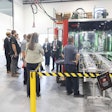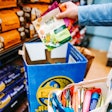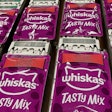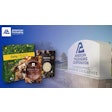How can you use packaging to differentiate your petfood products from the competition? The tools are out there. By using the latest packaging materials, graphics, barriers and machinery, you can do it.
Collaborate early
In the new product/package development process, contact BOTH container/material suppliers and packaging machinery manufacturers EARLY. Collaborate with them to develop and produce a package that will set your product apart from the competition. Do not make the common mistake of paying too little attention to packaging machinery in your planning process. Machinery is what transforms packaging ideas into packaging realities.
Gen 3 backlash
Generation 3 equipment is most often designed to be all electronicfully servo controlled. We're seeing some pushback from various end users in the US marketplace who do not want servo only machines. If there are too many servos on the line, the time commitment required by an electronic technician to maintain and service that equipment increases substantially.. This can be problematic, especially when operators are minimally trained and language differences are mixed in.
Generation 4 equipment is simple. It uses servos sparingly: only where absolutely needed. Generation 4 carries no real, independent definition. One suggestion is to think of Generation 4 as describing customer-centric machines, that are 5-S: Smart, simple, sophisticated, sturdy and standardcustomized to meet an individual manufacturer's needs.
Trends of change
Packaging is crucial in the US$35 billion global petfood market (Euromonitor). Petfood producers are vying for an increasing slice of this strong and steadily growing market and packaging is key to their efforts. Keeping up with, or better yet, ahead of packaging trends is a must. What packaging trends will stimulate changes in your operations?
Package types continue to evolve to mimic and, in some cases, lead consumer trends. From the growth of SUPs (stand-up pouches) to the continuing switch from paper bags to plastic, packagers employ many of the same package concepts and graphics that are successful for human consumer food offerings.
Lightweight and flexible
This continuing shift from heavy, rigid packaging to lightweight flexible packaging is seen in all sorts of product offerings. Individual portions of dog and cat foods, previously available mostly in cans, are increasingly being packed in foil/polyester/polypropylene "retort pouches" which can be opened without tools or appliances by consumers.
In fact, in the latest wave of retort pouch introductions, Whiskas led all other market segments, including human food. It introduced the retort package fully two years before Heinz (now Del Monte) introduced this package for StarKist Tuna. Use of retorted flexible pouches delivers two benefits: Foods are exposed to cooking heat for shorter periods of time vs. canned varieties, and high impact graphics can be incorporated for maximum retail shelf appeal.
Shaped pouches
But straight edge pouches (what the industry calls pillow or fin-sealed pouches) are not the only approach. While this package type is experiencing double digit growth in petfood (one supplier indicates it is the second largest growth area after beverages), shaped pouches, such as the Purina Friskies pouch, help provide that extra degree of differentiation.
According to Elliot Young, founder of Perception Research Services, consumers spend 7-10 seconds evaluating their options when faced with a variety of choices in the supermarket. Expect many more shaped entries, as the companies fight to grab consumers' attention in that brief 7-10-second slice of time.
Shift to convenience
Bagged products are shifting from paper (or multi-wall paper/poly structures) to all plastic bags. With this shift comes real consumer convenience in sealing/opening features. The string pulls and hot-melt glue seals of the paper sacks are being replaced by pressure-sensitive resealing tapes and plastic zippers.
Another convenience-based change is the movement to multipacking, which has been so successfully employed in the consumer beverage arena. Now, it is easy to find carton and shrinkwrapped multipack carriers that facilitate the purchase of six, eight, 12 packages of your pet's favorite foods. Some of these multipack carriers are paperboard and are produced from micro-flute corrugated. They are designed to carry high-impact graphics and promote convenient storage and dispensing of their contents.
Rigid containers
Rigid containers are also offering some unique shelf appeal. Purina's Fancy Feast Gourmet Gold, a dry cat food, is making its debut in a zippered SUP as well as a blow-molded high-density polyethylene canister with full body shrink sleeves carrying all brand and product identification. Canisters are sealed with a metallized polyester membrane and an LDPE overcap.
Another recent entry is the Iams line of sauces for dogs. Stock blow-molded PET bottles and PP closures are used; once again a full body shrink sleeve provides product/brand ID.
Finally there's PetRefresh drinking water, featured on the front page of the Wall Street Journal (March 11, 2005). This doggie water is available in a family of PET blow-molded bottles just like the designer waters offered to the pooches' people.
Equipment is key
Execution of your packaging strategy relies heavily on solid packaging operations. Remember, it is packaging equipment that transforms ideas into realities. A package that is entirely produced, filled, sealed, labeled and casepacked by hand is not a viable commercial container. It may be a limited run boutique container, but it isn't a viable commercial package for mass distribution until it can be automatically produced, filled, sealed, labeled and casepacked. The ability for machines to automatically complete these steps separates commercial packages from pipedreams.
When Masterfoods introduced the Whiskas® pouch, the firm needed to utilize contract packers and/or new machinery. The equipment used to fill, label, convey and pack pouches is completely different from that used for cans.
Control line choices
When selecting packaging machinery, remember: One size and type of machinery or line control does NOT fit all requirementseven in the same plant of a given company. In trying to understand the different types of line controls, consider using OMAC Packaging Workgroup (OPW) guidelines. Two in particular are particularly useful:
PackML for communicating between separate pieces of equipment; and
Line Types for describing the degree of automation on a line.
OPW describes PackML as "the language that machines would use if they could talk." These guidelines will aid a petfood company in linking machines for initial operation; routine service; and even relocation to another plant to take advantage of better manufacturing rates.
Second, utilize line type designations (Line Type 1, 2A, 2b, 3 and 4) for your in-plant team as well as prospective suppliers. With these well-defined designations, a packaging professional can identify the degree of automation their team expects on the line, as well as how operating performance parameters will be transmitted to the company's manufacturing management and ERP infrastructure.
Clarify collaboration
Another vital step is to clarify your firm's willingness to finance new developments in packaging. Such investments can benefit packagers and suppliers. One major petfood manufacturer stated they are actively open to collaboration for new package developments. This petfood packaging professional believes suppliers benefit since they receive funding to provide a solution specific to that end user. However, once the project is complete, the end user is often open to allowing the supplier to commercialize the developments in market segments outside the end user's specific market area.
Strong resources
During your planning, utilize the strong resources groups such as the Packaging Machinery Manufacturers Institute (PMMI) provide:
Subscribe to Ben Miyares' Packaging Management Update®. This free electronic newsletter has a weekly summary of current trends in all market segments. Go to www.packexpo.com, review the current issue and register.
Attend Pack Expo Las Vegas, September 26-28 in Las Vegas, Nevada, USA. There are more than 1,200 exhibitors with solutions.
Finally, it is worth repeating that early in your planning for a new product and/or package, you should begin collaborating with both material suppliers and packaging machinery manufacturers. Do not make the common mistake of paying too little attention to selecting the most suitable packaging machinery.












